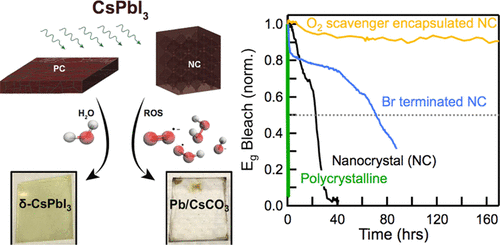当前位置:
X-MOL 学术
›
Chem. Mater.
›
论文详情
Our official English website, www.x-mol.net, welcomes your
feedback! (Note: you will need to create a separate account there.)
Beyond Strain: Controlling the Surface Chemistry of CsPbI3 Nanocrystal Films for Improved Stability against Ambient Reactive Oxygen Species
Chemistry of Materials ( IF 7.2 ) Pub Date : 2020-08-31 , DOI: 10.1021/acs.chemmater.0c02543 Taylor Moot 1 , Desislava R. Dikova 1, 2 , Abhijit Hazarika 1 , Tracy H. Schloemer 1, 3 , Severin N. Habisreutinger 1 , Noemi Leick 1 , Sean P. Dunfield 1, 4 , Bryan A. Rosales 1 , Steven P. Harvey 1 , Jason R. Pfeilsticker 1 , Glenn Teeter 1 , Lance M. Wheeler 1 , Bryon W. Larson 1 , Joseph M. Luther 1
Chemistry of Materials ( IF 7.2 ) Pub Date : 2020-08-31 , DOI: 10.1021/acs.chemmater.0c02543 Taylor Moot 1 , Desislava R. Dikova 1, 2 , Abhijit Hazarika 1 , Tracy H. Schloemer 1, 3 , Severin N. Habisreutinger 1 , Noemi Leick 1 , Sean P. Dunfield 1, 4 , Bryan A. Rosales 1 , Steven P. Harvey 1 , Jason R. Pfeilsticker 1 , Glenn Teeter 1 , Lance M. Wheeler 1 , Bryon W. Larson 1 , Joseph M. Luther 1
Affiliation

|
Colloidal halide perovskite nanocrystals (NCs) have the possibility of easy scale-up due to their batch synthesis and have demonstrated excellent optoelectronic properties. In particular, perovskite NCs have remarkably high photoluminescence quantum yields in solution and as thin films and impressive open circuit voltages in photovoltaic devices. Despite these promising results, little work has been done to understand the stability of CsPbI3 NCs for optoelectronic device applications. It has been previously shown that the ligands impart tensile surface strain, which stabilizes the black three-dimensional (3D) perovskite phase against phase degradation, making CsPbI3 NCs some of the most structurally robust inorganic halide perovskites to date. However, understanding exactly how CsPbI3 NCs degrade under ambient conditions is critical. We demonstrate that the degradation mechanism of NCs is unique from, and 2 orders of magnitude slower than, their polycrystalline thin-film counterparts. Under specific conditions, CsPbI3 NC films show a compositional instability instead of the phase instability seen in large grain CsPbI3. This is mediated through reactions with superoxide and other reactive oxygen species, which are initiated from surface defect states, O2 and light. We then use this mechanistic insight to identify multiple strategies to prolong the lifetimes of CsPbI3 NC films, by going beyond surface strain to mitigate key surface chemistries. We demonstrate that (1) minimizing the number of surface defects (2) using an alkylammonium bromide ligand surface treatment and (3) encapsulation with an oxygen scavenging layer all increase NC film lifetimes by inhibiting various steps in the photo-oxidation degradation reaction.
中文翻译:

超越应变:控制CsPbI 3纳米晶体薄膜的表面化学,以提高对环境活性氧物种的稳定性
胶态卤化物钙钛矿纳米晶体(NCs)由于其批量合成而具有易于放大的可能性,并显示出优异的光电性能。特别是钙钛矿型NC在溶液和薄膜中具有非常高的光致发光量子产率,并且在光伏器件中具有令人印象深刻的开路电压。尽管取得了这些令人鼓舞的结果,但对于了解用于光电设备应用的CsPbI 3 NC的稳定性,几乎没有做任何工作。先前已经证明,配体赋予拉伸表面应变,其稳定了黑色三维(3D)钙钛矿相免受相降解,使CsPbI 3 NCs成为迄今为止结构上最坚固的无机卤化物钙钛矿。但是,确切了解CsPbI在环境条件下3 NC降级至关重要。我们证明了NCs的降解机理是独特的,并且比其多晶薄膜对应物慢2个数量级。在特定条件下,CsPbI 3 NC膜显示出成分不稳定性,而不是大晶粒CsPbI 3中的相不稳定性。这是通过与超氧化物和其他活性氧的反应而介导的,这些氧是由表面缺陷态,O 2和光引发的。然后,我们使用这种机制的洞察力来确定延长CsPbI 3寿命的多种策略通过超越表面应变来减轻关键的表面化学成分,从而形成NC膜。我们证明(1)最小化表面缺陷的数量(2)使用烷基溴化铵配体表面处理和(3)用除氧层封装都通过抑制光氧化降解反应中的各个步骤来增加NC膜的寿命。
更新日期:2020-09-22
中文翻译:

超越应变:控制CsPbI 3纳米晶体薄膜的表面化学,以提高对环境活性氧物种的稳定性
胶态卤化物钙钛矿纳米晶体(NCs)由于其批量合成而具有易于放大的可能性,并显示出优异的光电性能。特别是钙钛矿型NC在溶液和薄膜中具有非常高的光致发光量子产率,并且在光伏器件中具有令人印象深刻的开路电压。尽管取得了这些令人鼓舞的结果,但对于了解用于光电设备应用的CsPbI 3 NC的稳定性,几乎没有做任何工作。先前已经证明,配体赋予拉伸表面应变,其稳定了黑色三维(3D)钙钛矿相免受相降解,使CsPbI 3 NCs成为迄今为止结构上最坚固的无机卤化物钙钛矿。但是,确切了解CsPbI在环境条件下3 NC降级至关重要。我们证明了NCs的降解机理是独特的,并且比其多晶薄膜对应物慢2个数量级。在特定条件下,CsPbI 3 NC膜显示出成分不稳定性,而不是大晶粒CsPbI 3中的相不稳定性。这是通过与超氧化物和其他活性氧的反应而介导的,这些氧是由表面缺陷态,O 2和光引发的。然后,我们使用这种机制的洞察力来确定延长CsPbI 3寿命的多种策略通过超越表面应变来减轻关键的表面化学成分,从而形成NC膜。我们证明(1)最小化表面缺陷的数量(2)使用烷基溴化铵配体表面处理和(3)用除氧层封装都通过抑制光氧化降解反应中的各个步骤来增加NC膜的寿命。











































 京公网安备 11010802027423号
京公网安备 11010802027423号